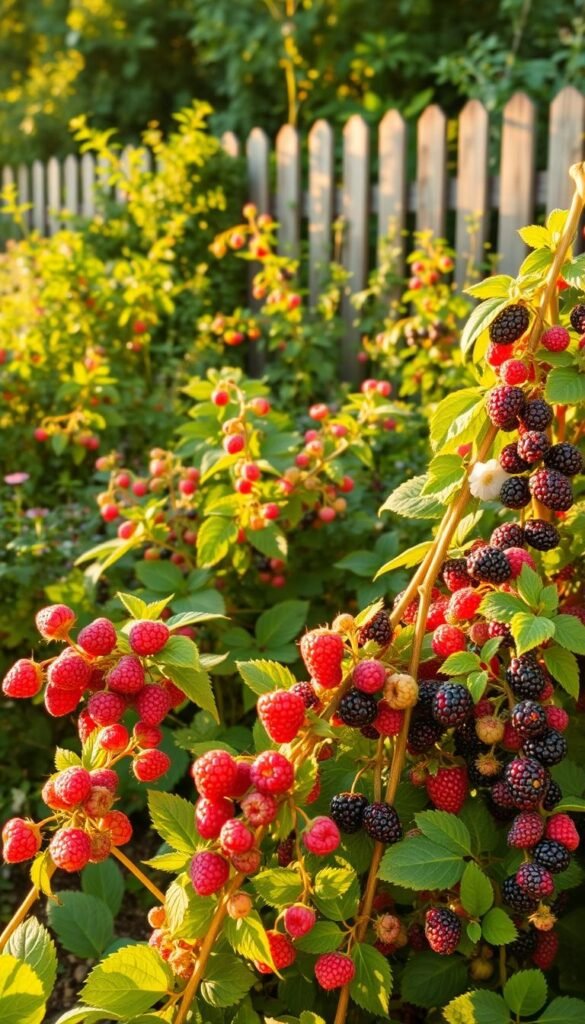Imagine stepping outside to pluck sun-warmed treats straight from your yard. Compact berry plants make this possible, even if you’re working with limited space. These versatile growers thrive in containers, raised beds, or tucked between flowers, turning patios, balconies, or tiny plots into productive edible landscapes.
Many varieties reward you with sweet rewards quickly – some produce juicy gems in their first season. Picture snacking on vibrant blueberries by summer or enjoying tart currants in homemade jams by fall. Beyond their tasty yields, these plants dress up your space with spring blossoms, lush greenery, and autumn hues.
What makes these shrubs ideal for beginners? They ask for little once settled. A sunny spot, occasional watering, and basic pruning keep them happy. You’ll love how they serve multiple roles: creating privacy screens, defining garden borders, or attracting pollinators while stocking your kitchen.
Growing your own means no more bland supermarket berries. Homegrown versions burst with flavor and nutrients, often costing less than store-bought pints. Whether you choose classic raspberries or experiment with goji varieties, each season brings new ways to enjoy your harvest – fresh snacks, baked goods, or frozen treats.
Introduction to Your Fruit Bushes Garden
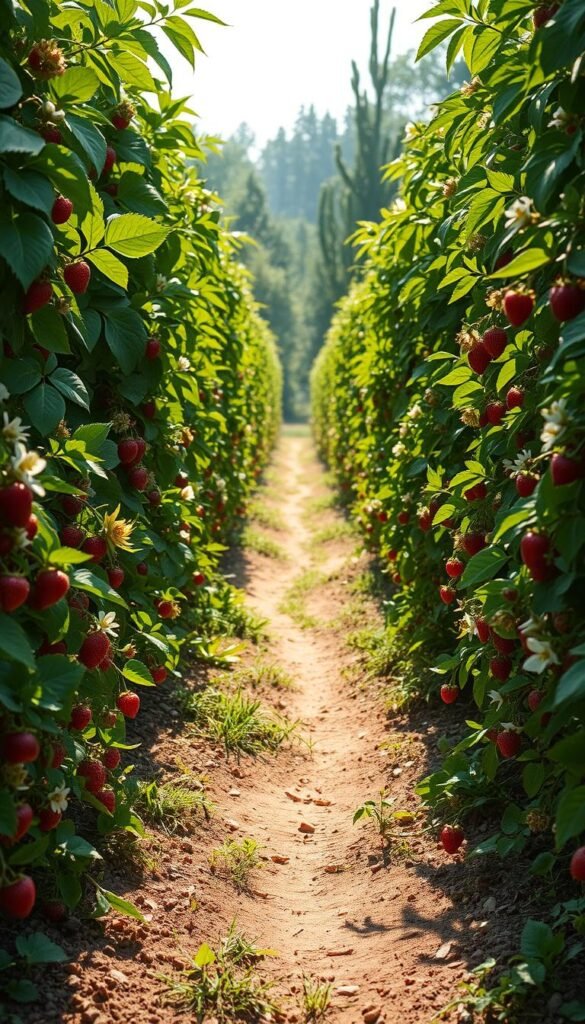
Discover how small spaces can yield big flavors with the right plants. These compact growers work overtime, serving as decorative elements while stocking your kitchen with vitamin-packed treats. Unlike traditional crops, they evolve with your landscape, offering new surprises each season.
What Makes These Plantings Unique?
Perennial powerhouses thrive year after year without replanting. Spring brings delicate blossoms that bees adore, while summer delivers jewel-toned snacks. Come fall, fiery foliage steals the show before winter dormancy.
You’ll love the double-duty design – edible borders can frame patios or screen unsightly views. Currant varieties like ‘Red Lake’ offer ruby clusters perfect for jellies, while blueberry types like ‘Top Hat’ stay under three feet tall.
Why Beginners Succeed Here
Three key advantages make these plantings ideal for newcomers:
- Minimal upkeep after establishment
- Adaptability to pots or cramped corners
- Continuous yields for 10+ years
Harvest timing becomes a delightful ritual. Pluck raspberries at dawn when sugars peak, or gather elderflowers for homemade syrups. With smart variety selection, you’ll enjoy something ripe from early summer through first frost.
Selecting the Perfect Berry and Shrub Varieties
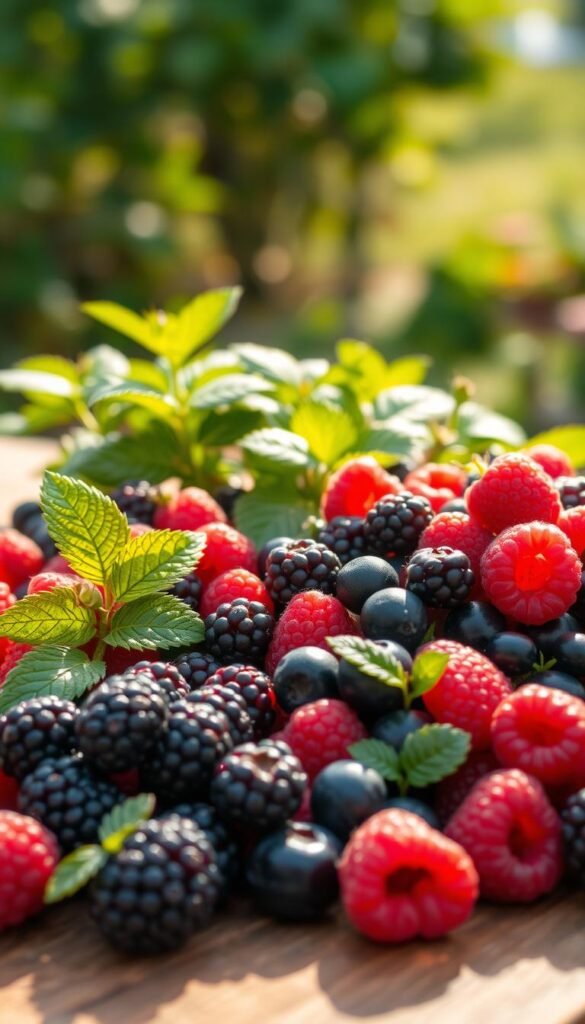
Your journey into homegrown flavors begins with smart plant choices. The right picks ensure juicy rewards while fitting your space and climate. Let’s explore top performers that balance taste with low maintenance.
Strawberries and Raspberries for Beginners
Start with strawberries to build confidence—they adapt quickly to containers or hanging baskets. Everbearing types like ‘Albion’ produce from June through frost, while June-bearing varieties deliver a burst of sweetness for preserves. Pair them with raspberries that fruit on first-year canes, such as ‘Heritage’, for hassle-free yields.
Blueberries, Blackberries, and Elderberries
Blueberry bushes thrive when you match them to your region. Northern growers love ‘Northblue’ (zones 3-7), while southerners choose ‘Sharpblue’ for heat tolerance. Modern blackberries ditch the thorns—try ‘Prime-Ark Freedom’ for painless picking. Elderberries shine as dual-purpose plants, offering immune-boosting berries and showy white blooms.
Exotic Options Like Goji and Honeyberries
Adventure seekers will adore honeyberries’ early summer crops and arctic-hardy nature. Plant two varieties like ‘Borealis’ and ‘Tundra’ for cross-pollination. Goji berries bring antioxidant power to sunny spots, thriving in poor soil where other plants struggle.
| Variety | Key Feature | Best For | Harvest Time |
|---|---|---|---|
| Strawberry ‘Albion’ | Everbearing | Containers | June – Frost |
| Raspberry ‘Heritage’ | Self-supporting canes | Small gardens | Summer & Fall |
| Blueberry ‘Sharpblue’ | Heat-tolerant | Zones 7-10 | May – July |
| Blackberry ‘Prime-Ark’ | Thornless | Family gardens | June – August |
Understanding Planting and Spacing Requirements
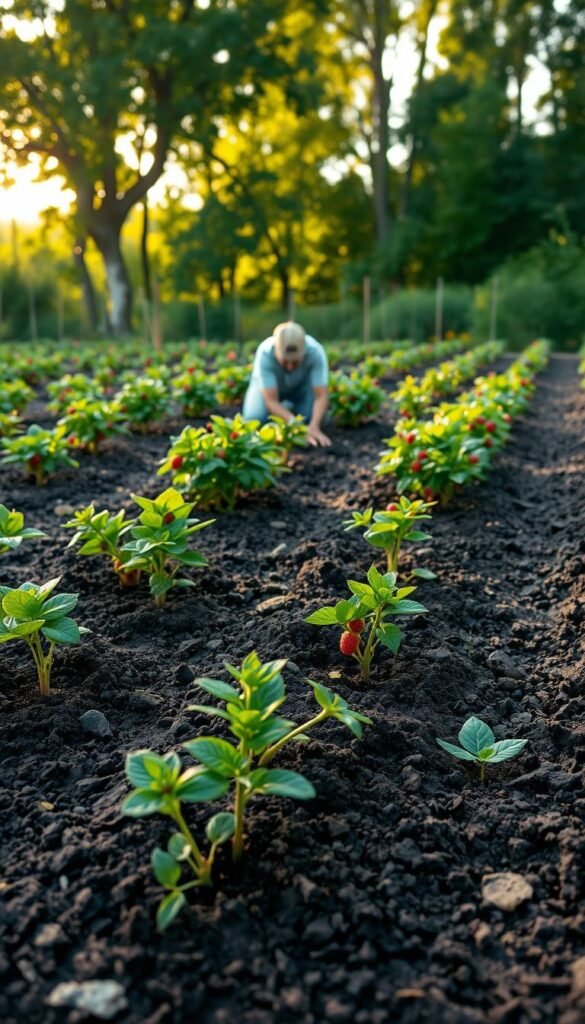
Getting your plants off to a strong start begins with smart placement and soil know-how. Proper setup prevents common issues like disease spread and nutrient competition, letting your green investments thrive for years.
Soil Preparation and pH Considerations
Test your soil’s pH before planting – blueberries demand acidic soil (4.0-5.5) to access nutrients. If your ground measures higher, mix peat moss or sulfur into the top 12 inches. For other varieties, aim for slightly acidic to neutral soil (6.0-7.0).
Enrich planting areas with compost or aged manure. This creates well-drained soil that holds moisture without waterlogging roots. Raised beds work wonders for heavy clay or alkaline soils, letting you control the growing environment.
Optimizing Space and Container Options
Follow these spacing guidelines for healthy growth:
- Strawberries: 12-18 inches apart
- Blueberries: 4-5 feet between plants
- Blackberries: 2-3 feet apart in rows
Containers solve space challenges beautifully. Choose 18-24″ pots for strawberries and dwarf blueberries. Ensure drainage holes and use potting mix with perlite for better root development. For patios, try tiered planters that let you grow multiple varieties vertically.
Caring for Your Fruit Bushes Garden: Sunlight, Water, and Soil Needs
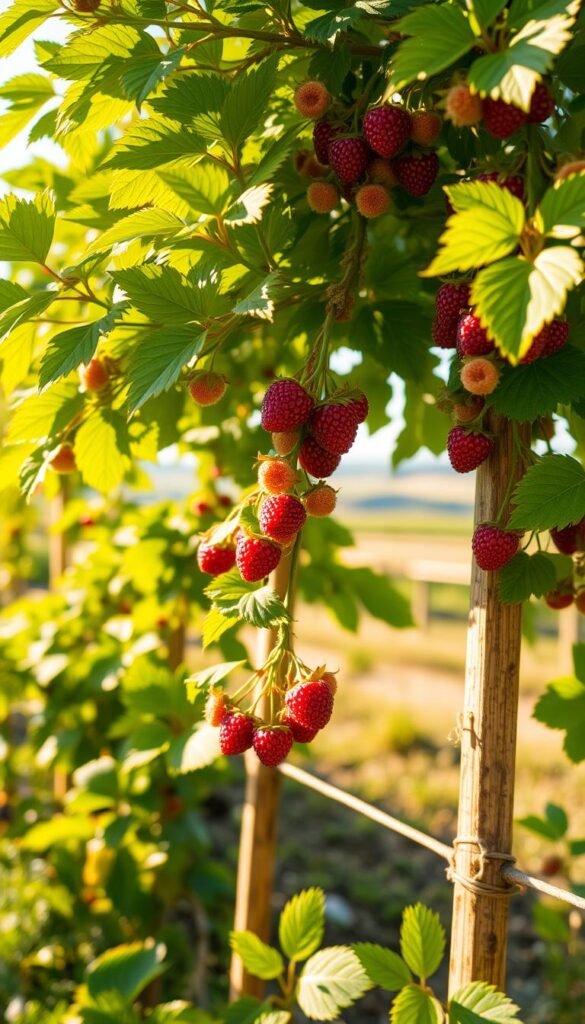
Healthy plants start with smart care routines. Most varieties crave 6-8 hours of full sun daily to develop their signature sweetness. Pair this with well-draining soil that holds moisture without becoming soggy – your plants will reward you with vibrant growth and juicy harvests.
Pruning, Fertilizing, and Maintenance Tips
Early spring is prime time for pruning. Remove dead or crowded branches to boost air circulation and light penetration. For cane berries like raspberries, cut older stems at ground level to energize new growth.
Feed your plants as they wake from dormancy. Use organic fertilizers designed for berries, applying them around the drip line. A 2-3 inch mulch layer keeps roots cool and suppresses weeds naturally.
Water deeply but infrequently to encourage strong root systems. Check soil moisture weekly – if the top inch feels dry, it’s time to hydrate. Container-grown varieties in small-space balcony gardens may need more frequent attention during heat waves.
Stay alert for pests or discolored leaves. Quick action with insecticidal soap or neem oil often solves minor issues. With these basics mastered, your edible landscape becomes both productive and low-fuss.
Fruit Bushes Garden: Easy-Care Berries and Other Shrubs for New Growers
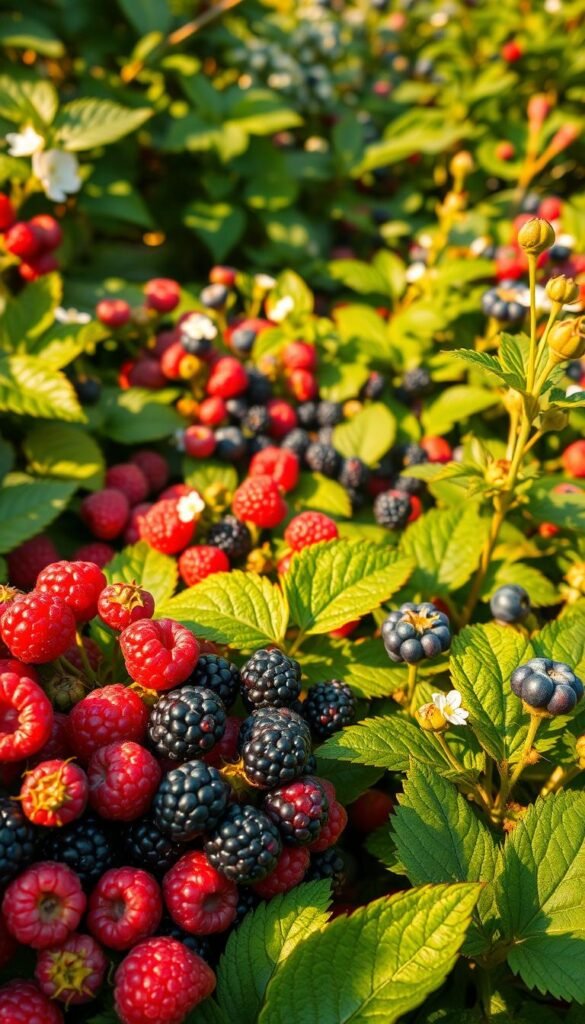
Growing your own snacks becomes surprisingly simple when working with nature’s most cooperative plants. These productive varieties meet you where you are, whether you’re nurturing a windowsill pot or transforming a backyard corner.
Why New Growers Love This Method
Quick rewards keep motivation high. Strawberries often deliver ripe treats within months, while summer raspberries shower you with fruit on second-year canes. Even slower starters like blueberries become low-maintenance producers once established.
See results faster than traditional gardening:
| Plant | First Harvest | Peak Production |
|---|---|---|
| Strawberries | 3-6 months | Year 2 |
| Raspberries | Year 2 | Year 3 |
| Blueberries | Year 2-3 | Year 5 |
| Blackberries | Year 2 | Year 3-4 |
Flexibility removes pressure. Start with three plants in containers, then expand as your confidence grows. Forgot to prune? Most varieties bounce back next season. Missed a watering? Established roots tolerate brief dry spells.
Your initial efforts multiply over time. A single raspberry cane becomes a fruiting thicket in three years. Blueberry bushes double their yield as they mature. This gradual growth pattern lets you learn alongside your plants without overwhelm.
Innovative Landscaping and Edible Borders for Compact Spaces
Turn overlooked corners into snack stations with clever plant arrangements. Berry plants double as living decor, blending beauty with practicality in tight areas. Even narrow side yards or balcony rails become productive when you think beyond traditional rows.
Creating Edible Borders and Privacy Hedges
Swap plain shrubs for tasty alternatives. Alpine Currant glows with crimson berries perfect for jams, while Oregon Grape Holly offers fragrant flowers and tart blue clusters. These multi-season performers screen views better than boxwood – plus you get snacks!
Vertical Gardening and Container Innovations
Stack your harvest upward. Trellises let blackberries climb fences without stealing ground space. The 2-foot-tall Top Hat Blueberry thrives in pots, letting you move plants to chase sunlight. Try hanging baskets for trailing strawberries that drip with ruby gems.
Mix heights for visual drama and maximum yield. Taller bushes create shade for low-growing varieties, while mid-sized plants fill gaps. This layered approach transforms blank walls into living pantries, proving small spaces can deliver big flavor.

